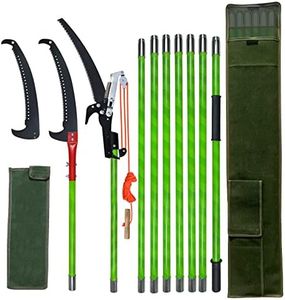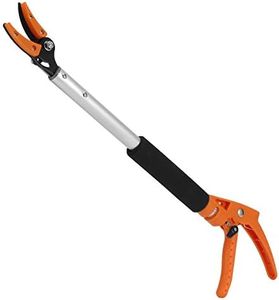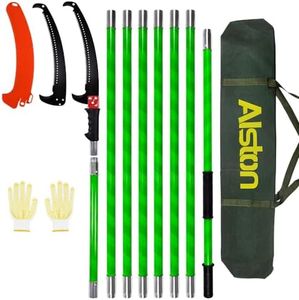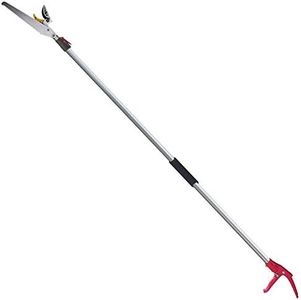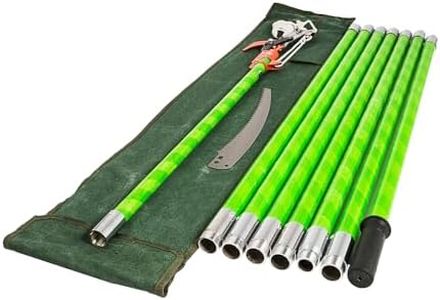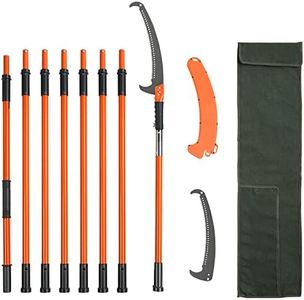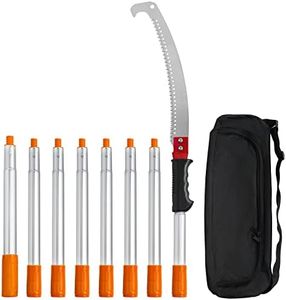We Use CookiesWe use cookies to enhance the security, performance,
functionality and for analytical and promotional activities. By continuing to browse this site you
are agreeing to our privacy policy
10 Best Telescoping Tree Pruners
From leading brands and best sellers available on the web.Recommended lists
Buying Guide for the Best Telescoping Tree Pruners
Choosing the right telescoping tree pruner can make a big difference in how easy and safe it is to maintain your trees and garden. The goal is to find a tool that reaches where you need to prune, is comfortable to use, and matches the thickness of the branches you intend to cut. Understanding the key features will help you select a pruner that fits your needs and will last for years.Maximum Reach (Length)Maximum reach refers to how long the pruner can extend, allowing you to cut branches higher off the ground without using a ladder. Telescoping tree pruners generally come in lengths ranging from about 6 feet to 16 feet or more. Shorter pruners (6-10 feet) are good for smaller trees or if you only need to reach moderately high branches. Longer options (12-16 feet and above) are for tall trees or harder-to-reach places. When choosing, think about the height of your trees and whether you want to avoid using ladders for both safety and convenience.
Cutting CapacityCutting capacity is about the maximum thickness of branches the pruner can handle, usually measured in inches. Light-duty pruners can typically cut branches up to about 1 inch thick, while heavy-duty models can cut 1.5 to 2 inches or more. Consider what size branches you’ll prune most often—if you deal mostly with small twigs and thin branches, a smaller capacity is fine. For thicker limbs, look for higher cutting capacity to avoid straining the tool or yourself.
Cutting MechanismThere are two main cutting mechanisms in telescoping pruners: bypass blades and saw blades. Bypass blades work like scissors and are best for cleanly cutting live branches up to their stated capacity, while saw blades are used for thicker or dead branches that can't be cut with bypass blades. Some pruners include both. Consider whether you'll mainly make clean, precise cuts on live wood or if you'll also need to saw larger or dead branches, which helps you pick the right combination.
Weight and Build MaterialThe weight and the material of your pruner determine both how easy it is to handle and how durable it will be. Lighter pruners (often made from aluminum or fiberglass) are easier to hold for longer periods and less tiring, while heavier ones (that use more steel) may feel sturdier but can be hard to use at full extension. If you plan to use the tool for long jobs or have lots of branches to prune, a lightweight option can be more comfortable to use. If you need extra durability for heavy work, consider a tougher build.
Locking MechanismThe locking mechanism keeps the telescoping sections in place at your chosen length. There are twist locks, clip locks, or push-button systems. A reliable, easy-to-use lock ensures your pruner doesn’t collapse or shift while in use, which is important for safety and efficiency. If you want quick adjustments, look for a mechanism that you can operate without much fuss, especially if you'll need to frequently change the length.
Grip and Comfort FeaturesGrip and comfort features include padded handles, ergonomic designs, and anti-slip coatings. Since telescoping pruners can be in use for a while and are often maneuvered overhead, these features help reduce hand fatigue and give you better control. If you have smaller hands or expect to use the pruner frequently, prioritize comfortable, ergonomic grips to minimize strain.

